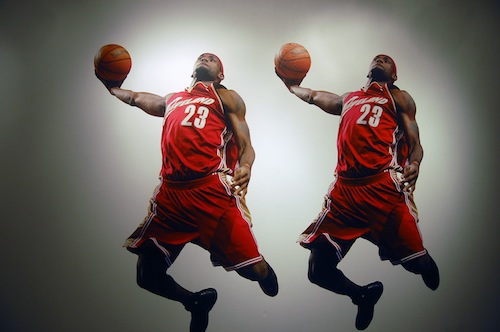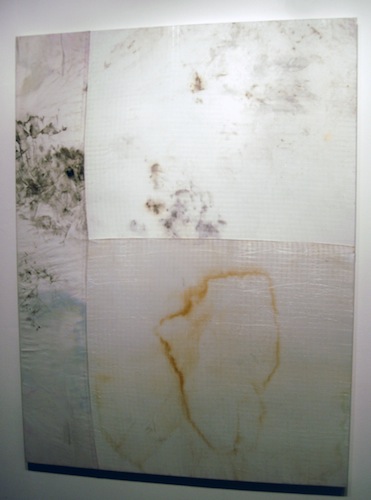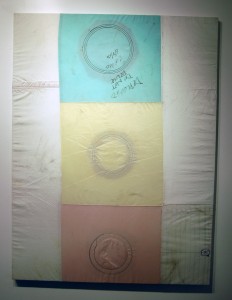Open Space’s Liberti(n)es, a multidisciplinary group show curated by Keith J. Varadi, explores the fine line between exercising and abusing personal freedoms. Varadi pulls work from across the spectrum, using audio CDs, digital prints, fiber art, paintings, sculpture, and zines. The wide array of media and vision is one of Liberti(n)es strengths.
As with many shows at Open Space, the use of the gallery’s zine library is a real treat, and the small publications on display could blissfully take up one’s whole afternoon. Pieces that stand out immediately are the large, deployed airbag “paintings” by Ross Iannatti. Standing over 5 feet tall, Iannatti sewed together used airbags, and stretched them tightly over the canvas bars. The paintings are surprisingly pleasing, despite being constructed from byproducts of tragedy and stirring up memories of violent auto collisions.
Other notable pieces include the digital prints of of Peter Sutherland and Benjamin Bellas. Sutherland’s series of four prints depict hummers, cowboy boots, Nirvana CDs, children atop a school bus, and a sign for Aberdeen Maryland (whose motto, “Come as you are,” humorously completes the circle with Cobain). Overlaying two photos into one print, Sutherland draws out murky associations of cause and effect. Bellas’ piece consists of two, oversized, cutouts of LeBron James in mid-dunk.
These attention grabbing prints from FatHead, a corporation who creates giant cutouts of American athletes, reference the infamous “Decision” made by LeBron in two-thousand ten. Using side by side duplicates in a gallery setting forces the audience to see the NBA star from a different point of view. Instead of seeing LeBron as a pop icon, it encourages a deeper look into the national insanity that surrounds this one basketball player and his career move three years ago.
A libertine, according to Webster’s dictionary, is a usually disparaging person who is unrestrained by convention or morality. The title of the show clearly states what Varadi aims to achieve – revealing what limits American liberties and why. The pieces in “Liberti(n)es” prefer to avoid statements of morality but leave it open to the audience to create their own arguments. It relies heavily on absurdities, such as multiple life-sized cutouts of NBA players, to make the intended revelations, often attempting to push liberties to the max to force them to collapse on themselves. Taking a step back, it is hard not to smirk at another general statement the show makes – Liberti(n)es takes a moment to brush its own shoulders off and say that artists, who often employ extremities to create statements or uncover truths, are a kind of libertine.
However, for a show that uses extremism and rampant freedom as its theme, Liberti(n)es delivers work that is more comfortable than one would expect. In the press release, the show is introduced by stating citizens assume they have agency over their liberties and then asks, “…but what happens when we lose this control or surrender this agency, willfully or not?”
And while the pieces are provocative the art never seems particularly ground breaking or unconventional. Admittedly, the curator states the pieces “are not joy rides, they are not car chases, they are slow strolls down back alleyways…”, playing with the idea of extremes in moderation. Regardless, the inclusion of more visually shocking or challenging work could have only improved the show.









